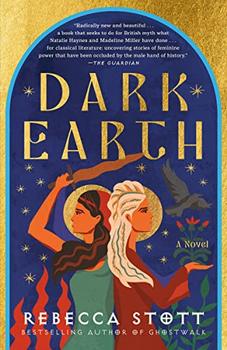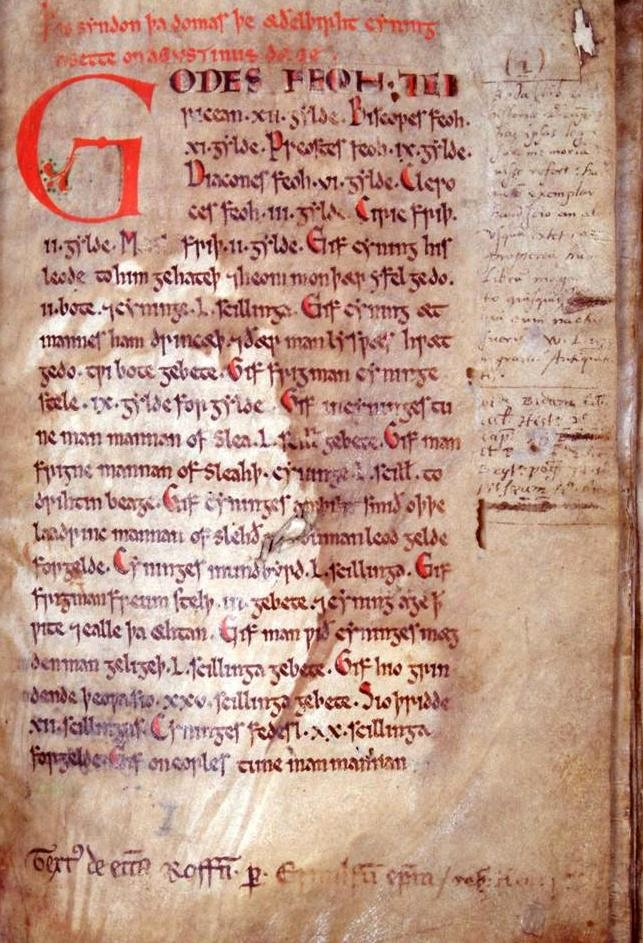Summary | Excerpt | Reviews | Beyond the Book | Read-Alikes | Genres & Themes | Author Bio

A Novel
by Rebecca StottThis article relates to Dark Earth
 In Dark Earth, sisters Isla and Blue attempt to claim protection from a warlord under the laws of sixth century England, while also hiding the fact that they've broken those laws. This part of British history was a time of transition, and the laws of the land were no exception to that. Starting in the fifth century, Germanic peoples immigrated to Britain. In the past it was believed they belonged to three tribes: the Angles, the Saxons and the Jutes — hence the term Anglo-Saxon. However, modern research has shown that these people were from a variety of groups, and much less unified than previously thought.
In Dark Earth, sisters Isla and Blue attempt to claim protection from a warlord under the laws of sixth century England, while also hiding the fact that they've broken those laws. This part of British history was a time of transition, and the laws of the land were no exception to that. Starting in the fifth century, Germanic peoples immigrated to Britain. In the past it was believed they belonged to three tribes: the Angles, the Saxons and the Jutes — hence the term Anglo-Saxon. However, modern research has shown that these people were from a variety of groups, and much less unified than previously thought.
When they arrived, they found a land already populated by a diverse mix of native Britons, displaced Romans and former Roman allies. There is ongoing debate as to how many people actually migrated to the British Isles and how they interacted with the people already there. Gildas, a monk writing in the sixth century, says that conflict arose between these groups. According to his account, the native Britons were able to temporarily repel the Germanic encroachment, but by the time he was writing, Anglo-Saxon kingdoms were established across what is now England and endured until the Norman invasion of 1066.
These kingdoms were not founded all at once, but grew gradually as warlords gained enough power to become overlords, then kings. Their laws developed from the traditions of the Anglo-Saxon tribes, with some influence from Roman law. Anglo-Saxon law enforced both the power of the lord or monarch and the traditional rights of free people. These rights mainly pertained to property, contracts and inheritance, and were enforced by communities and kin groups. As the kingdoms developed, so too did a more formal legal system that depended on royal power to a greater extent. Monarchs either formally codified or replaced traditional legal practices.
Despite the fact that there are more surviving legal documents from early medieval England than from concurrent European societies, many questions remain about the early development of their laws. In particular, it is often unclear which aspects of the law were new at the time of their recording, and which were older traditions recorded for the first time. This makes it difficult to say when or why changes to the law occurred. The earliest of these legal documents, and in fact the earliest surviving text in Old English, is a law code dated to the turn of the seventh century and attributed to Æthelberht of Kent. Only one copy survived to the present, found in a 12th-century manuscript from Rochester. The laws outlined in this document are very similar to early Germanic legal systems in other parts of Europe.
Many of the earliest laws dealt with crimes against people and property. For crimes against people, the offender would be required to pay a fine called a wergild (a term derived from the Old English words for "man" and "payment") to the victim or their family. Social status was very important to this system, since the amount of this payment would vary based on both the severity of the crime and the status of the victim. The more serious the crime, and the more important the victim, the higher the wergild would be. In some areas, perpetrators were required to pay a second fine to the monarch, in recompense for breaking their laws. This system was common among medieval Germanic states, though the details varied.
The Tribal Hidage, a list of the Anglo-Saxon tribes and their holdings, was written somewhere between the seventh and ninth centuries. By this time, the land was divided into sections based on what was considered necessary to support a family, rather than by a standard area. In some areas, these subdivisions were called "hides" and were generally between 60 to 120 acres depending on the quality of the land. One hundred hides formed an administrative unit known as a hundred. And then multiple hundreds formed a shire. "Hide" lives on in England as a surname and a place name, such as the town of Hyde near Manchester; and many English counties today carry the suffix "shire," such as Buckinghamshire, which contains an administrative area known as the Chiltern Hundreds. The shires were ruled by Ealdormen (from which the term "earl" later evolved) and the Shire-Reeve (later "sheriff") was responsible for law and order and collecting taxes. The Ealdormen were appointed by the king and served on his council, known as the Witan (wise men). This council elected the monarch from the royal family and held a great deal of political power.
While they would have involved some version of the system described here, it is difficult to say what the exact laws may have been in the particular time and place Dark Earth is set. This is due not only to the passage of time, but also the state of transition Britain was in during the sixth century. Though many details have been lost, Stott has brought to life what it might have been like to live through such a tumultuous period.
A copy of the opening page of the Law of Æthelberht courtesy of Rochester Cathedral Library
Filed under People, Eras & Events
![]() This "beyond the book article" relates to Dark Earth. It originally ran in September 2022 and has been updated for the
July 2023 paperback edition.
Go to magazine.
This "beyond the book article" relates to Dark Earth. It originally ran in September 2022 and has been updated for the
July 2023 paperback edition.
Go to magazine.




I write to add to the beauty that now belongs to me
Click Here to find out who said this, as well as discovering other famous literary quotes!
Your guide toexceptional books
BookBrowse seeks out and recommends the best in contemporary fiction and nonfiction—books that not only engage and entertain but also deepen our understanding of ourselves and the world around us.